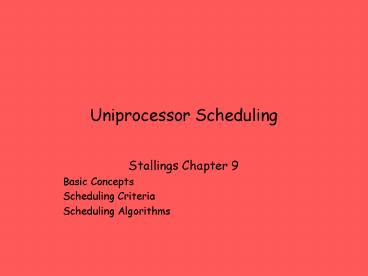Uniprocessor Scheduling - PowerPoint PPT Presentation
1 / 20
Title:
Uniprocessor Scheduling
Description:
preemption based on clock (interrupts on time slice or quantum -q- usually 10-100 msec) ... Another solution: Time slice each queue gets a fraction of CPU ... – PowerPoint PPT presentation
Number of Views:59
Avg rating:3.0/5.0
Title: Uniprocessor Scheduling
1
Uniprocessor Scheduling
- Stallings Chapter 9
- Basic Concepts
- Scheduling Criteria
- Scheduling Algorithms
2
Types of Scheduling
3
Long- and Medium-Term Schedulers
- Long-term scheduler
- Determines which programs are admitted to the
system (ie to become processes) - requests can be denied if e.g. thrashing or
overload - Medium-term scheduler
- decides when/which processes to suspend/resume
- Both control the degree of multiprogramming
- More processes, smaller percentage of time each
process is executed
4
Short-Term Scheduler
- Decides which process will be dispatched invoked
upon - Clock interrupts
- I/O interrupts
- Operating system calls
- Signals
- Dispatch latency time it takes for the
dispatcher to stop one process and start another
running the dominating factors involve - switching context
- selecting the new process to dispatch
5
CPUI/O Burst Cycle
- Process execution consists of a cycle of
- CPU execution and
- I/O wait.
- A process may be
- CPU-bound
- IO-bound
6
Scheduling Criteria- Optimization goals
- CPU utilization keep CPU as busy as possible
- Throughput of processes that complete their
execution per time unit - Response time amount of time it takes from when
a request was submitted until the first response
is produced (execution waiting time in ready
queue) - Turnaround time amount of time to execute a
particular process (execution all the waiting)
involves IO schedulers also - Fairness - watch priorities, avoid starvation,
... - Scheduler Efficiency - overhead (e.g. context
switching, computing priorities, )
7
Decision Mode
- Nonpreemptive
- Once a process is in the running state, it will
continue until it terminates or blocks itself for
I/O - Preemptive
- Currently running process may be interrupted and
moved to the Ready state by the operating system - Allows for better service since any one process
cannot monopolize the processor for very long
8
First-Come-First-Served(FCFS)
A
B
C
D
E
- non-preemptive
- Favors CPU-bound processes
- A short process may have to wait very long before
it can execute (convoy effect)
9
Round-Robin
A
B
C
D
E
- preemption based on clock (interrupts on time
slice or quantum -q- usually 10-100 msec) - fairness for n processes, each gets 1/n of the
CPU time in chunks of at most q time units - Performance
- q large ? FIFO
- q small ? overhead can be high due to context
switches
10
Shortest Process First
- Non-preemptive
- Short process jumps ahead of longer processes
- Avoid convoy effect
11
Shortest Remaining Time First
- Preemptive (at arrival) version of shortest
process next
12
On SPF Scheduling
- gives high throughput
- gives minimum (optimal) average response
(waiting) time for a given set of processes - Proof (non-preemptive) analyze the summation
giving the waiting time - must estimate processing time (next cpu burst)
- Can be done automatically (exponential averaging)
- If estimated time for process (given by the user
in a batch system) not correct, the operating
system may abort it - possibility of starvation for longer processes
13
Determining Length of Next CPU Burst
- Can be done by using the length of previous CPU
bursts, using exponential averaging.
14
On Exponential Averaging
- ? 0
- ?n1 ?n
- history does not count, only initial estimation
counts - ? 1
- ?n1 tn
- Only the actual last CPU burst counts.
- If we expand the formula, we get
- ?n1 ? tn(1 - ?) ? tn -1
- (1 - ? )j ? tn -i
- (1 - ? )n ?0
- Since both ? and (1 - ?) are less than or equal
to 1, each successive term has less weight than
its predecessor.
15
Priority Scheduling General Rules
- Scheduler can choose a process of higher priority
over one of lower priority - can be preemptive or non-preemptive
- can have multiple ready queues to represent
multiple level of priority - Example Priority Scheduling SPF, where priority
is the predicted next CPU burst time. - Problem ? Starvation low priority processes may
never execute. - A solution ? Aging as time progresses increase
the priority of the process.
16
Priority Scheduling Cont. Highest Response
Ratio Next (HRRN)
1
2
3
4
5
time spent waiting expected service
time expected service time
- Choose next process with highest ratio
- non-preemptive
- no starvation (aging employed)
- favours short processes
- overhead can be high
17
Priority Scheduling Cont. Multilevel Queue
- Ready queue is partitioned into separate queues,
eg - foreground (interactive)
- background (batch)
- Each queue has its own scheduling algorithm, eg
- foreground RR
- background FCFS
- Scheduling must be done between the queues.
- Fixed eg., serve all from foreground then from
background. Possible starvation. - Another solution Time slice each queue gets a
fraction of CPU time to divide amongst its
processes, eg. - 80 to foreground in RR
- 20 to background in FCFS
18
Multilevel Feedback Queue
- A process can move between the various queues
aging can be implemented this way. - scheduler parameters
- number of queues
- scheduling algorithm for each queue
- method to upgrade a process
- method to demote a process
- method to determine which queue a process will
enter first
19
Multilevel Feedback Queues
20
Fair-Share Scheduling
- extention of multi-level queues with feedback
priority recomputation - application runs as a collection of processes
(threads) - concern the performance of the application (ie.
group of processes/threads) - scheduling decisions based on process sets
- eg. traditional unix sheduling































